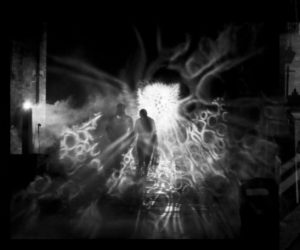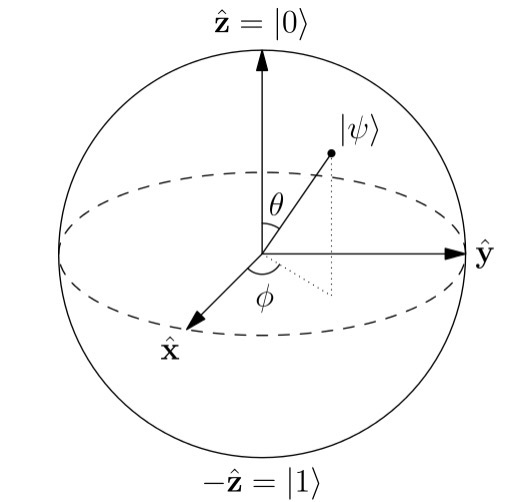Quantum computers may be 100 million times more powerful than today’s computers and they may do that by computing results simultaneously in multiple universes. Really?
Google and Nasa announced they were collaborating on the D-Wave X2 quantum computer, which they say is 100 million times faster than a conventional computer chip, in 2013. It can answer certain algorithms in seconds rather than years.
Google director of engineering, Hartmut Neven, said: “For a specific, carefully crafted proof-of-concept problem we achieve a 100-million-fold speed-up.” …
Representing information in qubits allows the information to be processed in ways that have no equivalent in classical computing, taking advantage of phenomena such as quantum tunneling and quantum entanglement.
As such, quantum computers may theoretically be able to solve certain problems in a few days that would take millions of years on a classical computer. (Source: Nasa)
… a moderate-sized quantum computer could perform computations of enormous complexity, greater complexity than the entire visible universe with all the atoms that we see, all taking place within a quantum computer consisting of just a few hundred atoms. … no single-universe explanation can account for quantum phenomena
Just as people before a certain time could not grasp the power of today’s computers, we do not grasp the potential of quantum computers. This is understandable because no one really “gets” quantum phenomena.
How can two “things” be linked in a way that changing one instantly changes the other, no matter how far apart they are? Entangled particles defy classical physics, yet there is no doubt today that this effect, which Einstein called “spooky action at a distance,” is real.
Quantum computer is to ordinary computer as smartphone is to abacus?
A recent post by RationalizingTheUniverse on the topic of Quantum Computing made the point “that an ordinary computer can never simulate a quantum computer” and that lead me to review why.
To understand why quantum computers are categorically different, and why they may give us unimagined power to manipulate matter and energy, consider the qubit.
The bit we use in computing today can be either 1 or 0. It has two possible states, on or off. What we have done with those gazillion little on/off switches has advanced our civilization to the point where someone from just 100 years ago would think we are insane. Talking to the air, laughing at our glowing hand, etc.
What insanity will we see 100 years from now if we upgrade our bits to qubits?
What does it mean that a qubit can be a 1, a 0, or both at the same time?
Visualize a single qubit as a sphere. When not entangled with another qubit, the value of its 1-ness or 0-ness can be any point on that sphere. If the current state of the q-bit is anywhere in the Southern Hemisphere of the sphere, it is read as a 1.
The possible states for a single qubit can be visualised using a Bloch sphere…. Represented on such a sphere, a classical bit could only be at the “North Pole” or the “South Pole”, … The rest of the surface of the sphere is inaccessible to a classical bit, but a pure qubit state can be represented by any point on the surface.
A qubit can be 1 or 0, or both 1 and 0 at the same time, but a qubit is not just a three state bit. When it is busy being both 1 and 0 at the same time, the qubit can have many different leanings toward 1-ness. It could be in Lima, Peru on the sphere, or Sidney. Australia. But careful with that analogy, qubits are not like little planets.
Entanglement of two or more qubits results in a mixed state, where they are mysteriously linked. You can visualize the qubit’s state as being within the sphere rather than at a point on the surface.
Once you see this model and puzzle about it for awhile, this question may occur: What is the resolution? In other words, how many different points on the surface and within the sphere are possible?
Assume for the sake of the model that there is no limit. What this might mean is mind-blowing: a single qubit with infinite states could contain a doorway to everything at all times in this universe.
Isn’t “everywhere” the only place to store an infinite number of things? Everything is in everything?
Understand that, and your respect for the potential of quantum computers will be appropriate.
… the computational power of a normal computer is dependent on the number of binary transistors – tiny power switches – that are contained within its microprocessor. Back in 1971 the first Intel processor was made up of 2,300 transistors. Intel now produce microprocessors with more than 5bn transistors. However, they’re still limited by their simple binary options. … with quantum computers the bits, or “qubits” as they are known, afford far more options owing to the uncertainty of their physical state. In the mysterious subatomic realm of quantum physics, particles can act like waves, so that they can be particle or wave or particle and wave. This is what’s known in quantum mechanics as superposition. As a result of superposition a qubit can be a 0 or 1 or 0 and 1. That means it can perform two equations at the same time. Two qubits can perform four equations. And three qubits can perform eight, and so on in an exponential expansion. That leads to some inconceivably large numbers, not to mention some mind-boggling working concepts.
“A thousand qubit computer can be in 2 to the 1,000 states at one time, which is 10 to the 300th power,” says D-Wave’s CEO, Vern Brownell. “There’s only 10 to the 80th atoms in the universe. Now does this mean it’s in 10 to the 300th universes at the same time?”
Can billions of different universes coexist within one computer? …
D-Wave’s 2X computer costs more than $15m and only a handful of organisations have so far bought one. Still, as those organisations include Google, Lockheed Martin and Nasa, and among D-Wave’s investors are Amazon’s Jeff Bezos and the CIA’s hi-tech arm, In-Q-Tel, it’s clear that some of the world’s most forward- looking institutions believe that the computer has a future. In areas such as artificial intelligence and cryptography, it’s thought that quantum computing will transform the landscape, perhaps bringing about the breakthrough that will enable machines to “think” with the nuance and interpretative skill of humans.… Rose chose … to develop an “adiabatic” quantum computer, which works by a process of what’s called “quantum annealing” or “tunnelling”. In essence, it means you develop an algorithm that assigns specific interactions between the qubits along the lines of the classical model – ie if this is a 0, that one is 1 etc. Then create the conditions for quantum superposition, in which the qubits can realise their near infinite possibilities, before returning them to the classical state of 0s and 1s. The idea is the qubits will follow the path of least energy in relation to the algorithmic requirements, thus finding the most efficient answer. … early results were not encouraging. No one seemed to be sure what, if anything, was going on at a quantum level, but whatever it was, it wasn’t impressive. D-Wave’s first demonstration in 2007 of its 16-qubit device, which involved solving a sudoku puzzle, hardly set the world on fire. … the company was regularly accused of hype and exaggeration. … it was very hard to measure with any agreed accuracy what was happening.
When D-Wave passed a … test, developed by an independent scientist, sceptics argued that while entanglement might be happening, the only real test was performance. …
[In] Google’s comparative test last year [the] D-Wave quantum computer solved certain problems 100m times faster than a classical computer.
“If it isn’t quantum computing,” asks Brownell, “then how did we build something that’s a hundred million times faster than an Intel Core? It either has to be quantum computing or some other law of nature that we haven’t discovered yet that’s even more exciting than quantum mechanics. I challenge any scientist in the world to tell us: if it’s not quantum annealing, what is it?”
Other universes, eh? Is consciousness a multi-universe phenomenon? My fiancé used to say that there is no imagination, that everything is real. That seemed completely crazy at the time. She said I was being narrow minded.
As I was thinking about this exchange we had, a cute bug appeared with some very unbuglike behaviors. It seemed to talk to me, not with words, but just by being there and by not acting like a bug, it seemed to trust me, even to hear and understand my thoughts.
It was totally still. I thought to it, “That you? Do push-ups if you can hear me.”
At that moment it started cleaning its antenna and I heard, “I’m not doing some stupid push-ups for you.”
This sort of thing has happened more times than I’d like to admit since she died, me sensing a surprising and familiar intelligence in the wind, clouds, whatever.
Bugs? Crazy … but if consciousness exists as a quantum phenomenon in billions of universes simultaneously, you wouldn’t need a big brain to have consciousness, right?
 I opened the window to let her out.
I opened the window to let her out.
“I’m going crazy,” I thought.
“The truth is crazy. Keep going,” I heard a voice encouraging my imagination.
Okay, if she could poke a bug into my universe to say “Hi”, then I could imagine myself into hers.
“Yes.”
This is what I saw. Somehow, it’s her. My love, the photographer, gifting me a vision of a universe where she is now, through the art of another photographer.
“I’m going crazy.”
“Enjoy it. It will pass.”
Everything is in everything.







